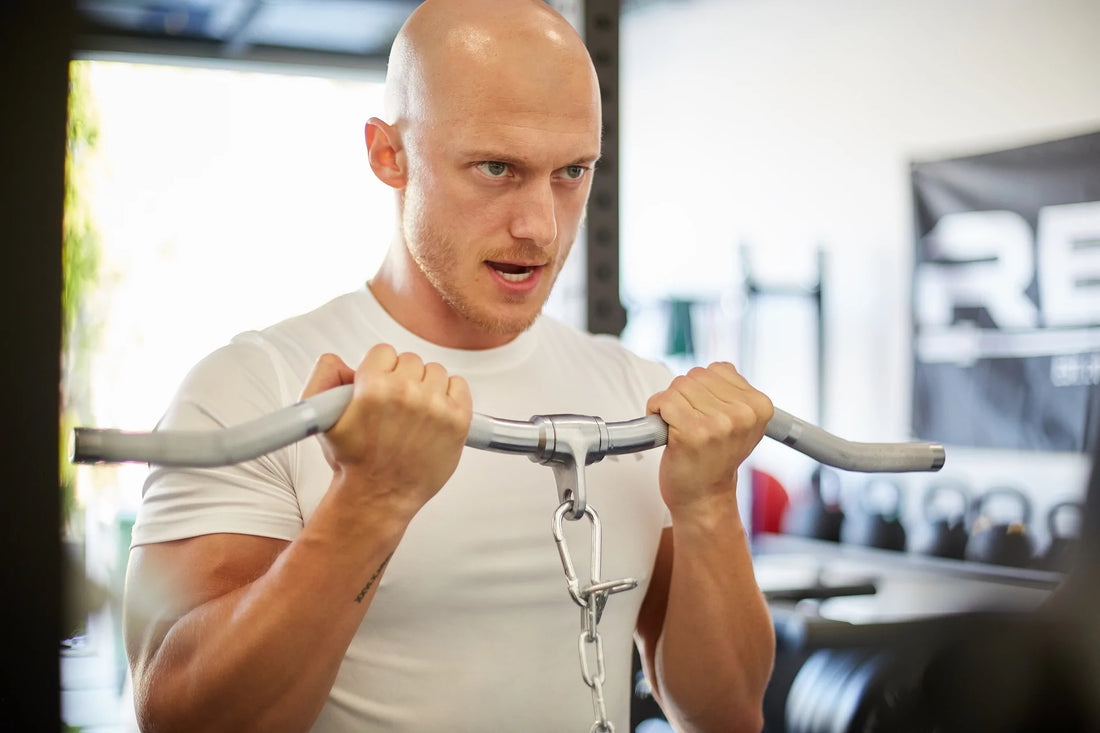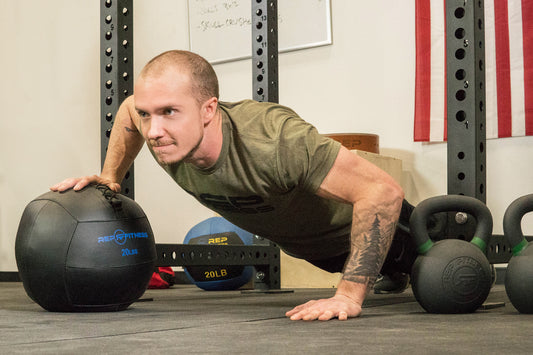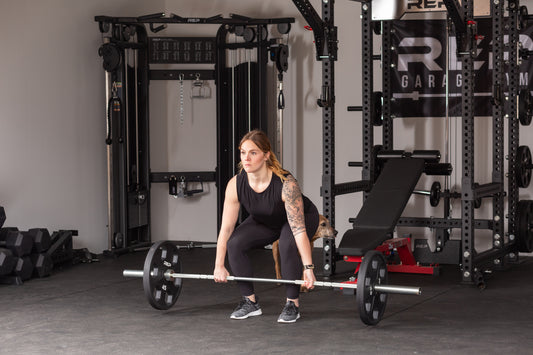
A cable machine, or functional trainer, can be one of the most versatile pieces of equipment in your home gym. Different attachments can completely transform the function of the cables and what muscle group you hit.
But a cable machine is only as good as your knowledge of how to use it.
So, here’s a quick look at the different cable grip attachments, what distinguishes them, and how to get the most out of them. We were feeling a little extra too, so we tapped into the expertise of Connor Kovacs, IFBB classic physique pro and competitive/lifestyle coach.

Connor Kovacs competing at an NPC bodybuilding show. Courtesy photo
“The best advice for cables is: Don’t make it too complicated,” he says. “A lot of people take cable exercises and try to do something fancy they saw online, but the best bet is to choose what’s logical for the goal you’re aiming to achieve. And the attachment to achieve that is going to be person-dependent, individualized for what you personally like.”
Don’t like to read? Check out the quick video: REP Cable Attachments, Performance Attachment Package.
LAT BARS
You probably know this one, and if you don’t, the name makes it obvious: A lat bar is most commonly used for lat pulldowns. But you can also use it for rows, curls, various tricep exercises, and more.
There are a variety of styles of lat pulldown bars.
The Solid Lat Bar is the most standard lat attachment, with no handles and a camber (bend) toward the ends. This bar has even more knurled areas for additional grip options, and it’s 26mm (about 1”) thick.
The Pro Series Lat Bar features cambered handles and more knurled grip areas so you can choose a straight, closer grip or a wide, angled grip on the camber (bend). It also is finished with rubber end caps. The Pro Series and Solid lat bars are the same length: 49”.
The Pro Series Neutral Grip Lat Bar features knurled handles, as well as a closer, knurled area to allow for different hand placements, including a neutral grip, which can be gentler on your shoulder and elbow joints (and it hits the muscles slightly differently). The handles are slightly thicker than the standard lat bar.
“Your back is comprised of more than just your lats and depending on the width and position of the grip you choose, you'll target one of the many back muscles in a primary, or biased, way,” Kovacs says.
The neutral grip bar will more directly activate your teres muscles, which is what you’re looking to build if you want a wider back, he says. It also has a little more lat activation than an overhand grip because of how you’re able to bring the elbow closer to the midline of the body, Kovacs says. But he says he likes to program a variety of different grips and angles for back to get it from every angle.
STRAIGHT BARS
Straight bar attachments are incredibly versatile, especially for upper-body movements.
They’re commonly used for tricep pushdowns and curls, although you can also use them for overhand seated rows (the straight bar feels more like a rowing erg; you can’t do neutral grip) and tons of other movements.
REP offers two styles of straight bars.
The Pro Series Straight Bar has knurled grip sections, as well as rubber-capped ends. The Pro Series attachments all have more knurling coverage than the basic attachments. The center of this attachment also has a 360-degree swivel.
The 20” Straight Bar is a basic straight bar attachment with slightly ergonomically contoured sides and subtle knurling.
ROW ATTACHMENTS
Again, the name clarifies the main purpose of these attachments – but don’t limit their uses to just seated or standing rows. You can also use them for tricep pushdowns, lat pulldowns, and other arm, shoulder, and back movements.
You can find three different types of row attachments:
A Triangle Row is perhaps the most common row attachment in the gym. It features two knurled handles that cause your palms to face each other in a neutral grip. The handles have an ergonomic taper shape, which some lifters prefer.
The Pro Series Triangle Row also features two neutral-grip grip handles. However, this attachment has is full knurl, whereas the regular Triangle Row only has a center knurl, and the Pro’s handles are straight, not ergo. The Pro Series connection points have a swivel joint for the attachment to move 360 degrees.
The Open Row attachment, with its open handle design, allows for a deeper range of motion than other row attachments, because the bar doesn’t hit your stomach when you pull back. Shallow knurling provides grip help. The handles are also wider apart than the triangle rows.
Whether you go with the Pro Series or regular Triangle Row is going to be a personal preference; they target the same muscles, Kovacs says. The main difference will be in grip and how that affects your hands, wrists, and forearms.
When using the triangle attachments for lat pulldowns, they will provide a different primary stimulus than the longer lat bar. With the triangles, your elbow is closer to midline, which can stimulate more of the lat than the wider pulldowns. Wider works more of the teres, rhomboids, and upper back, Kovacs says. Of course, both styles of pulldowns have full-back activation, although the primary bias depends on where the elbow travels.
HANDLES
Handles are pretty obvious how to use: grab and go. But REP’s two handles can be used in different ways:
The Sports Handle can be used with one or two hands, typically to cross-train other sports (hence the name), like golf, tennis, and baseball. You can also use it for cross-body movements, like wood choppers and single arm rear delt cable flies. Also try it for tricep kickbacks and hammer grip cable curls.
The Pro Series D-handle is for single-arm exercises, like pulls, curls, pushdowns, flies, side raises, front raises, or presses. The D-handle is best for unilateral upper body exercises. It’s incredibly versatile, making it one of Kovac’s personal favorite attachments.
There are two other kinds of D-handles, too:

The Urethane D-handle is made from a silver anodized aluminum with a urethane coating, and the strap is nylon.

The Steel D-handle (above) is bright zinc plated steel with medium-depth knurling and a nylon strap.
TRICEP ATTACHMENTS
There are two main tricep cable attachments, each with a unique function. Although these attachments are especially great for your tris, you can also use them in other ways (like biceps curls, rows, and face pulls).
The Tricep Pressdown Bar features an upside-down V shape with steel endcaps to hold your hands in place as you press weight down – or overhead. Or attach it to a low cable for curls. In addition to the endcaps, the standard knurling helps with grip.
Due to the hard frame, you are locked into that width/position. Many lifters find they can load this bar heavier than a Tricep Rope.
“Something some people don’t quite realize is a full extension of your triceps is when your hand travels slightly back behind your hips when doing pressdowns,” Kovacs says. “The rope allows you to bring your arms back and behind your hips, so you get a full contraction and deeper range of motion. You don’t hit your legs with a bar, so you can hit that larger head of the triceps a little deeper.”
OTHER ATTACHMENTS
Just like any other attachments, these are as versatile as your imagination.
The Multi-Grip Curl Bar features a cambered design that allows for various grip options, and the grippy handle rotates smoothly. While the bar is commonly used for bicep curls, you can also use it for tricep pushdowns, rows, and other arm, shoulder, and back movements – anything you do with a straight bar, but with different grip angles. The cambered angle can be gentler on your elbows and other joints. The bar is 25mm in diameter and about 28” long.
Compared with a straight bar for arm exercises, the Multi-Grip Bar’s ergonomic shape can be more comfortable for lifters with wrist or elbow issues; you can change the angle of the grip to find what’s comfortable for you, Kovacs says.
The different angles of the wrist can also target the bicep and forearm a little differently. Want to target the peak in your bicep? You’ll want the internal rotation of a supinated curl, where the pinky slightly rotates in toward the body at the top of the curl. A hammer curl activates the outer head of the bicep more.
“Even though the Multi-Grip Bar isn’t as exaggerated as those two examples, it puts the wrist in different positions with a similar emphasis,” Kovacs says.
The Ankle Cuff is one of the few cable attachments specially designed for lower body exercises. Just loop this fabric attachment around your ankle and use it for leg movements, like glute kickbacks, standing and lying cable hamstring curls, lateral lunges, standing leg extensions, hip abductors, and more.
“Think of it as how can you take your grip strength out of the equation or eliminate the stress on your wrist and forearm so you can still do certain upper body movements without the factor,” he says.

THE BOTTOM LINE
The bottom line, according to Kovacs? Everyone has a different body, as well as a different mental connection to their physicality.
“You can look at all of these grips, and they all serve a purpose. But at the end of the day, choose what feels best for you,” he says.
Take the lat bar and the neutral grip lat bar; they both primarily work the upper back.
“But if the neutral grip bar feels 5% more comfortable and that means you might give 5% more effort into the exercise, I’d rather see that than nitpick the grip you pick based on whatever convincing argument you may have heard,” Kovacs says. “In the grand scheme of things, it’s more about the effort going into the set than being super strict about the exercise.”
LOOKING FOR A MACHINE TO GO WITH ALL THOSE ATTACHMENTS?
Check out REP's functional trainers here.
More info:
















